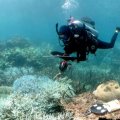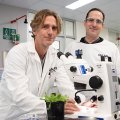The big swells caused by Tropical Cyclone Grace recently did more than just provide thrills for surfers.
The treacherous conditions washed up a fair share of natural marine wonders on North Stradbroke Island including the amazing sight of a partial humpback whale skeleton.
Locals alerted staff at The University of Queensland’s Moreton Bay Research Station to a huge whalebone that washed up half-way down the island said to be as tall as a man and appeared to weigh a couple of tones.
Station staff member Peter Fugelli later found a skull, several vertebrae and a large mass of very smelly blubber nearby.
“It was amazing to see it up close,” said Mr Fugelli.
“It is hard to imagine how big a whale is until you are standing right beside it.”
Representatives from the Queensland Museum and Queensland Parks and Wildlife Service have since removed the whale remains from the beach to be identified and catalogued.
“This find will greatly add to the current knowledge we have of whales in this part of Australia,” said Museum curator Dr Steve Van Dyke.
Cyclone season also means turtle hatchling season and while it is uncommon for turtle hatchlings to be found so far south, locals found a weak and injured Loggerhead youngster washed up on Straddie’s back beach.
“It was so weak when we found it that it could barely keep its head up,” Station manager and marine biologist Kathy Townsend said.
“It looked like it had been attacked as its back left side flipper had been bitten.
“We cleaned up the wound on its flipper and kept it in our aquarium system until it had regained its strength and then released at the place that it was found.”
The big seas also saw masses of unusual jelly-like creatures washed up on the ocean side of the beach that were identified as free-living salps.
“They are not actually jelly fish rather they are more closely related to animals such as sea squirts, which you often find attached to rocks in the surf zone,” Ms Townsend said..
“But unlike sea squirts, salps spend their entire life floating freely in the ocean currents.
“The tadpole like organ in the center is the actual animal, while the jelly like structure is its ‘house’. It uses this house to collect microscopic plankton on which it feeds.”
Samples of the salps have been passed on to the Museum for their collection.
Media: For more information contact Andrew Dunne at UQ Communications (telephone 3365 2802).
.jpg)



